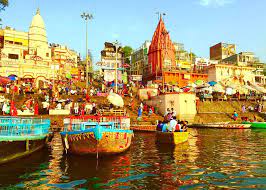Preface – Varanasi, also known as Banaras and Kashi or Varanasi, is one of the many famous religious places in the northern Indian state of Uttar Pradesh. It is considered one of the most sacred cities in Hinduism. This city has been a cultural and religious center of India, especially in North India, for centuries. This city ensconced in the lap of Mother Ganga is an unbroken display of India’s culture and civilization in the world. Varanasi, the famous city of Shiva, where Lord Shiva resides in every particle and all the devotees have unique devotion and love towards Bhole. After independence, Varanasi was renamed Varanasi

What is the story of the name Banaras?
The most famous name of Varanasi is Banaras. During the reign of the Mughals and the British in India, its name was Banaras only. Actually it was named Banarasi in Pali language. But later its name became Banaras. As far as Banaras is concerned. It is associated with a king named Banar who was killed during an attack by Muhammad Ghori.
Faith towards Kashi Vishwanath Temple in Varanasi
Kashi Vishwanath Temple is dedicated to Lord Shiva. The most famous Hindu temple here is the Jyotirlinga, one of the 12 Jyotirlingas of Lord Shiva, believed to be located in the Kashi Vishwanath Temple. This temple is considered to be the place of Lord Shiva and Mother Parvati. It is believed that just by visiting this temple once and taking a bath in the holy Ganges, one attains salvation, That is why Varanasi means Kashi is called Mokshadayini.
The Kashi Vishwanath temple in Varanasi was destroyed several times by the Muslim invaders
The temple was destroyed many times by many Muslim invaders in the history of India. And it is amazing that our clever historians of India have cleverly written this topic in the pages of history by twisting it. Also all these historians have tried to erase the history of India. According to the Chinese traveler Hiuen Tsang, there were hundred temples in Kashi at that time, but the Muslim invaders destroyed all the temples and built a mosque.
History of Vishwanath temple in Varanasi
This Vishwanath temple was built by King Harishchandra in the 11th century BC, it was demolished in 1194 by Mohammad Gauri after looting it. Then it was made a grand temple by the Sultan of Jaunpur but this led to the demolition of the temple by Mahmud Shah. It was again built grand temple again in 1585 by Raja Todarmal at this place but this grand temple was tried to be demolished in 1632 by the order of Shahjahan due to the strong resistance of the Hindus, the Vishwanath temple was destroyed in the central part of the temple.
The temple could not be demolished but 63 other temples of Kashi were demolished. After this, during the reign of Shah Jahan’s son Aurangzeb, on 18 April 1669, Aurangzeb issued a decree ordering the demolition of the main temple of Kashi Vishwanath. This decree is still safe in the Asiatic Library, Kolkata; on the orders of Aurangzeb, a Gyanvapi mosque was built by demolishing the temple here. On 2 September 1669, Aurangzeb destroyed the temple of Kashi Vishwanath. Aurangzeb had passed an order to convert thousands of Brahmins to Muslims every day at the point of a sword.
Even today, the ancestors of 90% of the Muslims of Uttar Pradesh are Brahmins. In 1777-80, a grand temple of Kashi Vishwanath was built here by Queen Ahilyabai, the queen of Indore. On which Maharaja Ranjit of Punjab had offered a gold medallion. Maharani Baijabai of Gwalior built the pavilion of Gyanvapi and the Maharaja of Nepal installed a huge Nandi statue here. The Gyanvapi mosque adjacent to the Kashi Vishwanath temple was captured by the Muslims. Gyanvaapi means well of knowledge in Sanskrit.
In 1991, a legal battle is going on to remove this mosque and build a temple, and after the survey of 2022, it came into the limelight that a Shivling of 12.8 diameters has been found in the Vajukhana of the mosque. The knowledge was widely hidden by the then chief priest to save it from attack.
Final Thought
At present, after the decision of Ram Mandir as per the prediction of India’s eminent Guru Sant Swami Rambhadracharya ji, now Kashi Vishwanath and Mathura. There is evidence of demolishing temples and building mosques at both the places and when the time comes, a decision will be taken by the court at both the places and a grand temple will be built at both the places.
By: Shakshi Sonvani
Write and Win: Participate in Creative writing Contest & International Essay Contest and win fabulous prizes.














